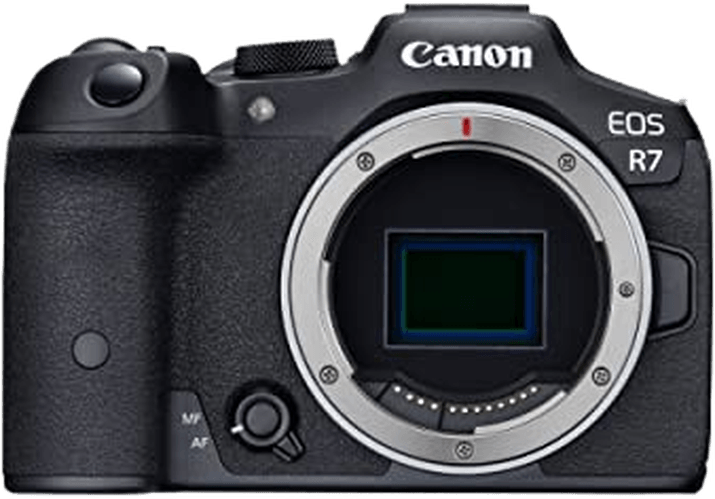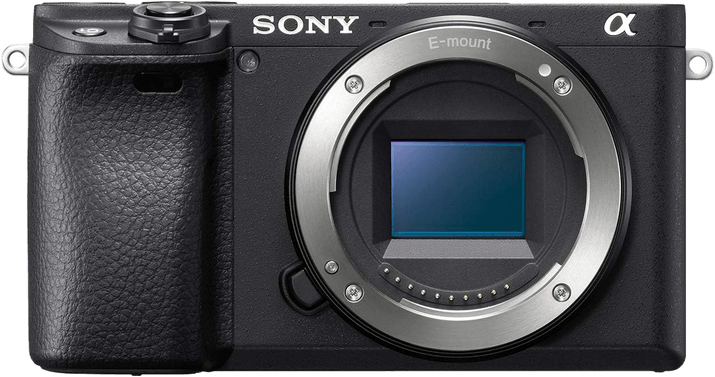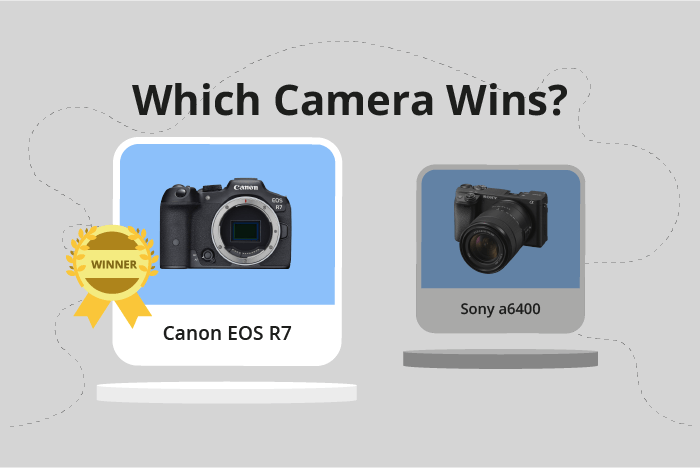Canon EOS R7 vs Sony a6400 Comparison
Canon EOS R7

Sony a6400

The Canon EOS R7 outperforms the Sony a6400 with a 13-point lead, scoring 83/100 compared to the a6400’s 70/100. Both cameras are mirrorless and were released in 2022 and 2019, respectively. The EOS R7 is priced at $1500, while the a6400 is available for $900.
The two cameras share similarities, but the Canon EOS R7 has advantages like its larger size (132 x 90 x 92mm) and heavier weight (612g / 1.35lbs), which may provide better stability and grip. On the other hand, the Sony a6400 is more compact (120 x 67 x 60mm) and lighter (403g / 0.89lbs), making it more portable and easier to carry.
Despite the Sony a6400’s lower score, its lower price and compact design might be more appealing to some users. However, the Canon EOS R7’s higher score and better specifications make it the superior option for those seeking better performance and features.
Canon EOS R7 vs Sony a6400 Overview and Optics
The Canon EOS R7 outperforms the Sony a6400 in optics, scoring 82/100 compared to the Sony’s 68/100. Both cameras share some common specifications, such as having a CMOS sensor, APS-C sensor size, and shooting speed. However, the Canon EOS R7 surpasses the Sony a6400 in several areas, making it the superior choice in terms of optics.
The Canon EOS R7 has a higher megapixel count at 33 compared to the Sony a6400’s 24.2, allowing for more detailed images. The R7 also boasts a faster shooting speed of 15, while the a6400 lags behind at 11. The Digic X processor in the Canon EOS R7 is more advanced than the Bionz X processor in the Sony a6400, contributing to better image quality and performance. The R7’s sensor has a higher DXOMARK score of 97, while the a6400’s sensor scores 83, indicating a better overall image quality in the Canon camera. Additionally, the Canon EOS R7 features image stabilization, which the Sony a6400 lacks.
The Sony a6400, however, has a few advantages over the Canon EOS R7. Its lens mount is compatible with the more extensive range of Sony E lenses, providing more options for photographers. However, this advantage does not outweigh the overall superiority of the Canon EOS R7 in optics.
In comparing the optics of the Canon EOS R7 and the Sony a6400, the Canon EOS R7 clearly comes out ahead. With a higher score, superior specifications, and better image quality, the Canon EOS R7 is the stronger choice for those seeking top-notch optics in their camera.
Canon EOS R7 vs Sony a6400 Video Performance
The Canon EOS R7 and Sony a6400 are evenly matched in terms of video capabilities, both earning a video score of 91 out of 100. They share key specifications, including a maximum video resolution of 4K, maximum video dimensions of 3840 x 2160, a maximum video frame rate of 120fps, and built-in time-lapse functionality.
The Canon EOS R7 excels in providing a user-friendly interface and seamless integration with Canon’s extensive lineup of lenses. This compatibility allows for greater flexibility and creative options when shooting video. Additionally, the EOS R7 is known for its color science, which produces more accurate and pleasing colors straight out of the camera, saving time in post-production.
On the other hand, the Sony a6400 has a slight advantage in low-light performance due to its higher ISO range. This allows the camera to capture better quality video in challenging lighting conditions. Moreover, the a6400 features a more compact and lightweight design, making it a more portable option for videographers on the go.
Taking these factors into consideration, the Canon EOS R7 stands out for its user-friendly interface, lens compatibility, and superior color science. However, the Sony a6400 may be a better choice for those prioritizing low-light performance and portability. Despite their differences, both cameras offer impressive video capabilities, making either an excellent choice for videographers seeking a high-quality camera.
Canon EOS R7 vs Sony a6400 Features and Benefits
The Canon EOS R7 wins the features battle with a score of 85/100, while the Sony a6400 scores 81/100. Both cameras share some common specifications, such as a 3-inch screen size, touchscreen capability, flip screen, absence of GPS, and the presence of WIFI and Bluetooth connectivity.
The Canon EOS R7 outperforms the Sony a6400 in terms of screen resolution, boasting 1,620,000 dots compared to the Sony a6400’s 921,600 dots. This higher screen resolution allows for crisper and clearer image previews and better menu navigation on the Canon EOS R7.
On the other hand, the Sony a6400 does not have any specific advantages over the Canon EOS R7 in terms of features. Both cameras have similar specifications, with the only notable difference being the screen resolution in favor of the Canon EOS R7.
Considering the points mentioned, the Canon EOS R7 is the superior camera in terms of features, mainly due to its higher screen resolution. The Sony a6400, while not having any distinct advantages, remains a competitive option for those looking for a camera with similar features. Both cameras provide a touchscreen, flip screen, and wireless connectivity options, making either a viable choice for photography enthusiasts. However, the higher screen resolution of the Canon EOS R7 sets it apart as the better camera in this comparison.
Canon EOS R7 vs Sony a6400 Storage and Battery
The Canon EOS R7 outperforms the Sony a6400 in storage and battery with a score of 79/100, while the Sony a6400 scores 37/100. Both cameras accept SD, SDHC, and SDXC memory cards and support USB charging. However, the Canon EOS R7 has two memory card slots and is compatible with faster UHS-II cards, while the Sony a6400 has only one slot and is compatible with UHS-I cards.
The Canon EOS R7 offers a longer battery life of 660 shots and uses the LP-E6NH battery type, compared to the Sony a6400’s 410 shots and NP-FW50 battery type. This advantage makes the Canon EOS R7 more suitable for prolonged use and professional work.
The Sony a6400, however, does not have any specific advantages in storage and battery over the Canon EOS R7. The Canon EOS R7 is the clear winner in this category, providing better storage options with faster memory card compatibility, two card slots, and a longer-lasting battery for extended shooting sessions.
Canon EOS R7 vs Sony a6400 – Our Verdict
Are you still undecided about which camera is right for you? Have a look at these popular comparisons that feature the Canon EOS R7 or the Sony a6400:

